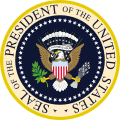 Cleveland delivering his inaugural address | |
| Date | March 4, 1885 |
|---|---|
| Location | United States Capitol, Washington, D.C. |
| Participants | Grover Cleveland 22nd president of the United States — Assuming office Morrison Waite Chief Justice of the United States — Administering oath Thomas A. Hendricks 21st vice president of the United States — Assuming office George F. Edmunds President pro tempore of the United States Senate — Administering oath |
| ||
|---|---|---|
Personal 28th Governor of New York 22nd & 24th President of the United States
Tenure Presidential campaigns Legacy
 | ||
The inauguration of Grover Cleveland as the 22nd president of the United States took place on Wednesday, March 4, 1885, at the East Portico of the United States Capitol in Washington, D.C. This was the 25th inauguration and marked the commencement of the first four-year term of Grover Cleveland as president and the only term of Thomas A. Hendricks as vice president. Hendricks died 266 days into this term, and the office remained vacant since there was no constitutional provision which allow an intra-term vice-presidential office filling; it would be regulated by the Twenty-fifth Amendment in 1967.
Contents
Chief Justice Morrison Waite administered the presidential oath of office, and Cleveland held a Bible given to him at age 15 by his mother as he recited it. [1] Cleveland's second inauguration took place eight years after the first, as his two terms in office were not consecutive. He was the first U.S. president to serve nonconsecutive terms. [2]
In the presidential election of 1884, Cleveland won New York by only 1,500 votes out of over a million cast (Statistics taken from Miller Center). He was the first Democrat to win the presidency since the Civil War. In his first speech as president, he emphasized the importance of healing partisan divisions and encouraged citizens to scrutinize the government. At the time, there was a lot of political fighting between different parties, which Cleveland wanted to change. Additionally, he urged the American people to uphold the Declaration of Independence and not be afraid to overthrow a tyrannical government, should the need arise.
